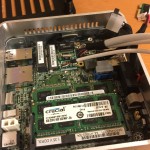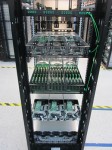After some frustration with stability and latency connecting my virtual pfSense router to my cable and DSL modems, I decided to switch to a physical box. I selected the Netgate RCC-VE 2440 as my hardware platform, since it’s the same box that pfSense themselves use as their OEM bundle. It also checks all the boxes with a dual-core Atom CPU, four Gigabit Ethernet ports, and low-power fanless design. Here’s my first impression and installation notes!
Intel
Faster Ethernet Gets Weird
“One size fits all” doesn’t work for Ethernet, but this proliferation of speed options sounds like trouble without automatic capability negotiation. It’s nice to have options, but the IEEE must remain focused on interoperability and rein in the interests of the various companies proposing next-generation Ethernet technologies.
Adding a Second Ethernet Port to an Intel NUC via Mini PCIe
As I mentioned in my previous post about Raspberry Pi power monitoring, I recently built a VMware vSphere “datacenter” from three Intel NUC mini PC’s. One limit of the NUC is that it has just one Ethernet port. But there’s a Mini PCIe slot inside the fourth-generation NUC that can be used to add a second Ethernet NIC!
Musing: Could We Replace Ethernet With PCIe?
Greg “EtherealMind” Ferro recently “mused” that it might be a good idea to replace PCI Express (PCIe) inside servers or rack-scale infrastructure with Ethernet. But this seems to be the exact opposite of the direction the industry is headed. Rather than replacing PCIe with Ethernet, companies like Intel seem set on replacing short-range Ethernet (in rack-scale systems) with PCIe!
The Rack Endgame: Open Compute Project
On reading my thoughts about the evolution of enterprise storage, many pointed out that this looks an awful lot like the Facebook-led Open Compute Project (OCP). This is entirely intentional. But OCP is simply one expression of this new architecture, and perhaps not the best one for the enterprise.




